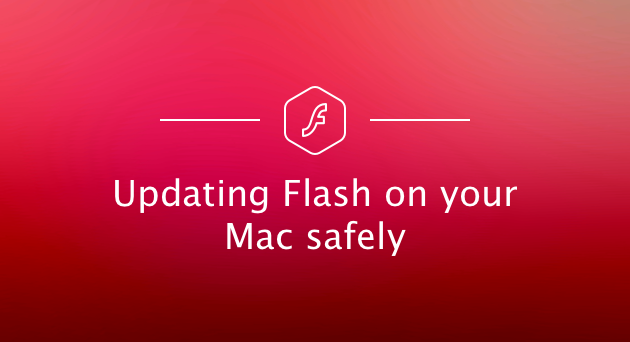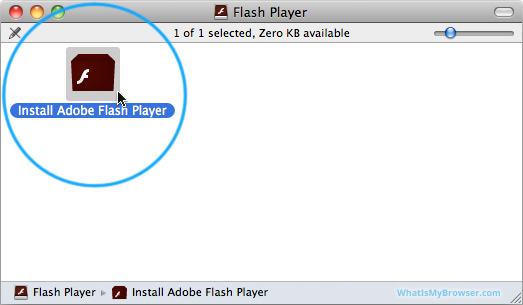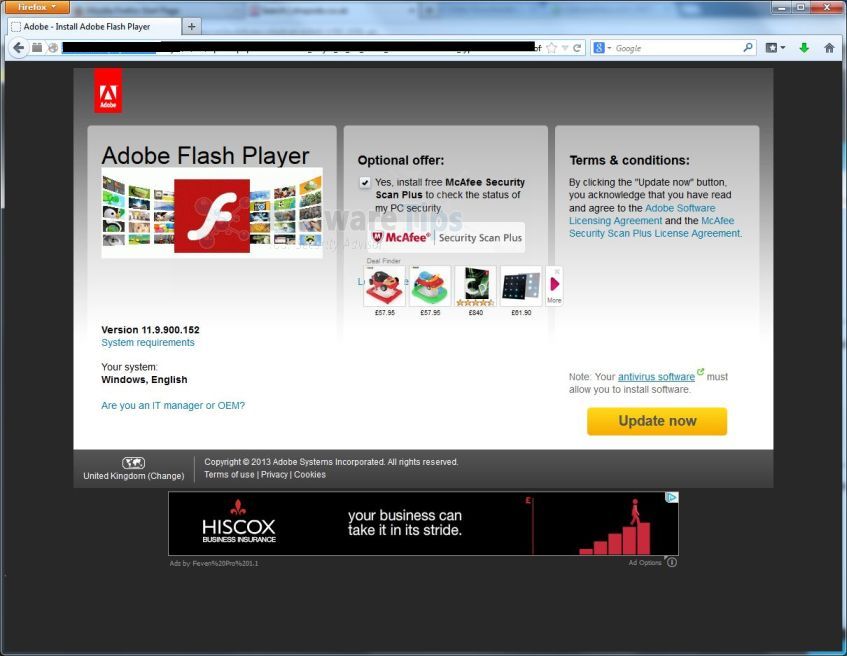Either let adobe install the flash player updates automatically or disable the updates forever. Disabling/Auto Install updates To customise your settings for disabling updates or to enable auto installs on a Mac.
The Fake Flash Player Update PopUp is a web browser advertisement shown by scammers that are trying to trick you into downloading adware installers. They do this by showing an alert that states that Flash is outdated or needs to be updated. When a user clicks on the download button, though, it will download an adware installer rather than the legitimate Flash installer. It goes without saying that you should ignore these alerts and just close the window if you encounter them.
When a fake Flash Update PopUp is displayed in your browser it will display an alert that states something like:
WARNING! Your Flash Player is out of date. Please install update to continue.
Update your Flash Player.
How to disable adobe flash player automatic updates in windows The tips I’m about sharing is for windows users, be it window 7, 8, 8.1, or even 10 A tip for Mac users on how to disable adobe flash player automatic updates will be shared soon. On Windows, you can also change the setting in the Control Panel. Double-click Flash Player, click the Advanced tab, and select an option under Updates. On Mac OS, you can also go to the System Preferences and double-click the Flash Player icon. Scroll down to Adobe Flash Player and click the Disable link. Disable Flash in Apple Safari (OS X) Apple doesn't put Flash on its iOS devices, but you may have it installed on your MacBook or iMac. Step 1, Open Start. Click the Windows logo in the bottom-left corner of the screen.Step 2, Open Control Panel. Type in control panel, then click the blue Control Panel icon at the top of the Start menu.Step 3, Click the 'View by' drop-down box. It's in the upper-right corner of the Control Panel window. A drop-down menu will appear. Adobe Flash has caused many problems in the past, with critical vulnerabilities frequently being exposed and Adobe regularly being required to release security updates. On Windows, you can also change the setting in the Control Panel. Double-click Flash Player, click the Advanced tab, and select an option under Updates. On Mac OS, you can also go to the System Preferences and double-click the Flash Player icon.
Your Flash Player for windows might be out of date!
Update the latest version for better perfomance.
Your update is ready

Once again, while your Flash Player installation may in fact be outdated, the site has no way of knowing this. This is just a scam to try and trick you into download the fake update so that the scammers can install further adware and unwanted programs on your computer.
Thankfully, these scams can be closed by simply opening Windows Task Manager and ending the browser process. It is important, though, that if you end the browser process that you do not reopen previously closed sites if prompted by the browser when you start it again as this will just reopen the scam.

On the other hand, if you are constantly seeing these types of fake update popups, tech support scams, or pages opening by themselves, then it may be possible that you are infected with an adware or other unwanted program that are displaying them. Once again, do not worry as it is quite easy to remove these infections if you follow the guide below.
Why am I Seeing these Fake Flash Update PopUps in my Browser?
The Fake Outdated Flash scam is shown through advertisements that redirect you to sites that display this scam. These advertisements can be displayed by installed adware programs or through less than reputable sites that are displaying them to generate advertising revenue.
For the most part, if you see a browser based scam like this, then you can simply close the browser and start it again. On the other hand, if you are continuously seeing scams with alerts like 'Outdated Flash Player' or 'Flash Player Update Available', then you should scan your computer for adware and remove anything that is found.
How irritating is this problem? (14 votes, average: 4.93)Loading...
This page aims to help you remove Fake Adobe Flash Player. Our removal instructions work for Safari, Chrome, Firefox and Internet Explorer, as well as every version of Windows and Mac.
If you are wondering what has recently been going on with your browsers, here is your answer:
In case you have been experiencing unwanted Internet ad generation combined with some unwanted and sudden browser redirects as well as the replacement of your previous homepage and search engine, then, unfortunately, your PC has likely been affected by Fake Adobe Flash Player (or a similar page-redirect). Note that this is not the genuine Adobe Flash Player but a browser hijacker-like program pretending to be the real thing!
Fake Adobe Flash Player is known as a browser redirect/browser hijacker. Such products could affect the performance and appearance of all the browsing programs that you have on your PC – Safari, Firefox, Chrome, Internet Explorer, Opera or any other browser could get affected by such a hijacker.
That is the reason why we are reviewing these hijackers below and you will see exactly what they are like and how to treat and clean your PC of them.
Hijackers – threats or simple annoyances?
Talking about browser hijackers, we need to state that the majority of their versions are not really dangerous or harmful in any way. Still, the level of irritation they may provoke can be so significant that most of the online users prefer to have them removed from their systems.
Redirects are a branch of the advertising-oriented software. Along with the Adware versions, they serve as marketing tools and provide the successful promotion of various software products, webpages and services online. You see, as we have certain advertising shown on the TV or on the radio, it is also normal to have it online. And that’s what the page redirects such as Fake Adobe Flash Player do – they advertise different things by opening the pages about them (usually without your clear consent), by generating the ads related to them or by simply putting them as your new homepages and search engines.
However, such a behaviour could be rather unwanted and intrusive which is the reason why hijackers like Fake Adobe Flash Player are typically considered PUPs (potentially unwanted programs).
What else could be done against Fake Adobe Flash Player?
Fake Adobe Flash Player can be fought by using the instructions inside our Removal Guide below. All the steps have been carefully prepared to help you remove this redirect so make sure to carefully complete them all if you wish to get rid of the hijacker.
Fake Adobe Flash Player Removal
If you have a Windows virus, continue with the guide below.

If you have a Mac virus, please use our How to remove Ads on Mac guide.
If you have an Android virus, please use our Android Malware Removal guide.
If you have an iPhone virus, please use our iPhone Virus Removal guide
Some of the steps will likely require you to exit the page. Bookmark it for later reference.
Reboot in Safe Mode (use this guide if you don’t know how to do it).
WARNING! READ CAREFULLY BEFORE PROCEEDING!
OPTIONAL OFFER
We get asked this a lot, so we are putting it here:Removing parasite manually may take hours and damage your system in the process. We recommend downloading ComboCleaner to see if it can detect parasite's files for you.
More information about ComboCleaner and steps to uninstall. Please review ComboCleaner's EULA and Privacy Policy. Keep in mind, only ComboCleaner’s scanner is free. If it detects a malware, you'll need to purchase its full version to remove it.
Press CTRL + SHIFT + ESC at the same time and go to the Processes Tab (the “Details” Tab on Win 8 and 10). Try to determine which processes are dangerous.
Right click on each of them and select Open File Location. Then scan the files with our free online virus scanner:
Drag and Drop Files Here to ScanThis scanner is free and will always remain free for our website's users. You can find its full-page version at: https://howtoremove.guide/online-virus-scanner/
Scan Results
| Virus Scanner | Result |
|---|---|
| ClamAV | |
| AVG AV | |
| Maldet |
After you open their folder, end the processes that are infected, then delete their folders.
Note: If you are sure something is part of the infection – delete it, even if the scanner doesn’t flag it. No anti-virus program can detect all infections.
Hold together the StartKeyand R. Type appwiz.cpl –>OK.
You are now in the Control Panel. Look for suspicious entries.Uninstall it/them.
Type msconfig in the search field and hit enter. A window will pop-up:
Startup —>Uncheck entries that have “Unknown” as Manufacturer or otherwise look suspicious.
Hold the Start Keyand R – copy +paste the following and click OK:
notepad %windir%/system32/Drivers/etc/hosts
A new file will open. If you are hacked, there will be a bunch of other IPs connected to you at the bottom. Look at the image below:
If there are suspicious IPs below “Localhost” – write to us in the comments.
Open the start menu and search for Network Connections (On Windows 10 you just write it after clicking the Windows button), press enter.
- Right-click on the Network Adapter you are using —> Properties —>Internet Protocol Version 4 (ICP/IP), click Properties.
- The DNS line should be set to Obtain DNS server automatically. If it is not, set it yourself.
- Click on Advanced —> the DNS tab. Remove everything here (if there is something) —> OK.
- After you complete this step, the threat will be gone from your browsers. Finish the next step as well or it may reappear on a system reboot.
Right click on the browser’s shortcut —> Properties.
NOTE: We are showing Google Chrome, but you can do this for Firefox and IE (or Edge).
Properties —–> Shortcut. In Target, remove everything after .exe.
Remove Fake Adobe Flash Player from Internet Explorer:
Open IE, click —–> Manage Add-ons.
Find the threat —>Disable. Go to —–> Internet Options —> change the URL to whatever you use (if hijacked) —>Apply.
Remove Fake Adobe Flash Player from Firefox:
Open Firefox, click ——-> Add-ons —->Extensions.
Find the adware/malware —> Remove.
Remove Fake Adobe Flash Player from Chrome:
Close Chrome. Navigate to:
C:/Users/!!!!USER NAME!!!!/AppData/Local/Google/Chrome/User Data. There is a Folder called “Default” inside:
Rename it to Backup Default. Restart Chrome.
OPTIONAL OFFERTo remove parasite on your own, you may have to meddle with system files and registries. If you were to do this, you need to be do be extremely careful, because you may damage your system.
If you want to avoid the risk, we recommend downloading ComboCleaner - a professional malware removal tool - to see whether it will find malicious programs on your mac.
Updates For Adobe Reader
Download ComboCleaner
Keep in mind, ComboCleaner’s malware scanner is free. If it detects a malware, you'll need to purchase its full version to remove it. More information about ComboCleaner and steps to uninstall. If you want to read up more on its policies, please review ComboCleaner's EULA and Privacy Policy.
Type Regedit in the windows search field and press Enter.
Inside, press CTRL and F together and type the threat’s Name. Right click and delete any entries you find with a similar name. If they don’t show up this way, go manually to these directories and delete/uninstall them:
- HKEY_CURRENT_USER—-Software—–Random Directory. It could be any one of them – ask us if you can’t discern which ones are malicious.
HKEY_CURRENT_USER—-Software—Microsoft—-Windows—CurrentVersion—Run– Random
HKEY_CURRENT_USER—-Software—Microsoft—Internet Explorer—-Main—- Random
If the guide doesn’t help, download the anti-virus program we recommended or try our free online virus scanner. Also, you can always ask us in the comments for help!
What makes Fake Adobe Flash Player and the other redirects suspicious?
These page-redirects have some suspicious features such as trying to find out what products you might like by accessing the surfing history data of your browsers. This is not illegal but could be annoying because later on, only the ads related to your search requests will be shown and you may end up having your browser flooded by all sorts of irritating pop-ups and banners.
What else makes the redirects like Fake Adobe Flash Player quite suspicious is the way they may get distributed. Usually, they use some tricky ways to make the users install them on their devices. That happens because hijackers are NOT malware and they typically cannot self-install on your machine without your consent (informed or uninformed) – they usually need you to authorize their installation. Therefore, their major sources, the so-called file bundles, are what you ought to be on the lookout for. Bundles are free software installers that contain a main program (usually the one that the user actually wants installed on their PC) and added software applications (this is where hijackers typically are). Such bundles usually contain some useful software and you might really become interested in trying some of the offered free apps. Still, you might need to read the EULAs and manuals because there might be a browser hijacker or a form of Adware added to the bundle and your browsers could end up infected and needlessly modified.
You can minimize the risks of getting contaminated by Fake Adobe Flash Player, though. All you must do is customize the installation of the software that you want on your PC.
How to install bundles, but opt-out of the potential hijackers inside them?
The right way to install anything on your PC is by carefully reading all the terms and conditions info that is presented. Also, it is essential to choose the extended/custom/advanced installation option that allows for an advanced installation mode. Those options of the wizard are all about letting you customize different aspects of the installation process. By selecting them, you will have the chance opt-out of any optional clauses and added software that you might not want to get installed on your computer.
Make an effort to avoid the quick installation features as much as you can. They might be easy to perform and might save you time but going for them could also turn out to be a pain in the neck if there was anything unwanted bundled with the main piece of software. Such features are often named Recommended, Quick or Easy. Do not use them for the sake of your clean and safe system.
SUMMARY:
Adobe Flash Player For Mac
| Name | Fake Adobe Flash Player |
| Type | Browser Hijacker |
| Danger Level | Medium (nowhere near threats like Ransomware, but still a security risk) |
| Symptoms | Ad generation, redirects, browser homepages/search engines which are unusual. |
| Distribution Method | Via many different sources such as bundles, shareware, spam, etc. |
| Detection Tool | parasite may reinstall itself multiple times if you don't delete its core files. We recommend downloading ComboCleaner to scan for malicious programs. This may save you hours and cut down your time to about 15 minutes. Download ComboCleaner Anti-Malware More information on ComboCleaner, steps to uninstall, EULA and Privacy Policy. If ComboCleaner detects a malware, you will have to purchase a license to remove it. |
Flash Player Update For Apple
Keep in mind, SpyHunter’s malware detection tool is free. To remove the infection, you’ll need to purchase the full version. More information about SpyHunter and steps to uninstall.